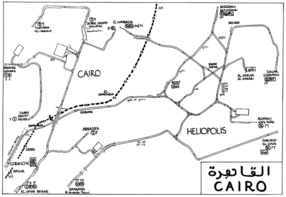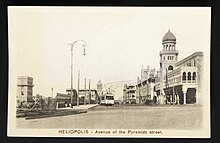Cairo tram
| Cairo tram | |
|---|---|
| Tram at the Ramses train station | |
| Basic information | |
| Country | Egypt |
| city | Cairo |
| opening | August 12, 1896 |
| operator | CTA |
| Infrastructure | |
| Gauge | 1000 mm ( meter gauge ) |
| Power system | Overhead line |
| business | |
| Lines | 9 |
| Line length | 30 km |
| Track plan 1996 | |
The tram Cairo is next to the tram Alexandria is one of two today in Egypt operated tram systems . The meter-gauge network is served by 9 lines and covers a length of around 30 kilometers. The Cairo Transport Authority has been operating it in Cairo and the Heliopolis district since 1991 . Before that there was an independent Heliopolis society.
history
On August 12, 1896, the first tram line was opened in Cairo. The network was built and initially operated by the Belgian company SA des Tramways du Caire . The route network grew rapidly. As early as 1917 there were 22 lines in Cairo - some crossed the Nile and thus connected Cairo with its neighboring city of Giza . The history of the city of Heliopolis is inextricably linked with the tram. In 1906, the Belgian Baron Édouard Empain founded the Chemins de fer électriques du Caire et des oasis d'Héliopolis , which bought 25 square kilometers of land in the desert northwest of Cairo at a reasonable price. When construction began in 1906/1907, the company built the new city of Heliopolis. The tram in Heliopolis opened on September 5, 1908 and was operated by the same company until 1992.
After the opening of the metro on September 27, 1987, most of the previously severely shrunk tram network in Cairo was shut down and, with the exception of the connection to the suburb of Heliopolis, was completely demolished. Today essentially only the Heliopolis system still exists. According to reports, operations there also ceased in spring 2019.
In Cairo, the intersection-free express tram route from the main train station remained parallel to the subway in the north-east direction and via a route to Heliopolis. This is followed by an extensive and widely ramified network in Heliopolis, which leads with connecting routes to Schubra al-Chaima in the northeast and Nasser City in the southeast.
The vehicles and tracks are in poor condition. The driving speed is therefore severely restricted and not competitive with road traffic. Timetables and route network plans are not available. The tram is the cheapest mode of transport in the Greater Cairo area at a fare of £ 1 . However, the utilization of the vehicles is rather low compared to the buses and underground trains. Three-car trains are used on the express connection between Cairo and Heliopolis, and two-car trains in Heliopolis.
Planning
For a long time, the continued existence of the tram network in Cairo and Heliopolis was not guaranteed. Other underground lines should replace the tram. In 2013 it was announced that a modern tram line would be built from the main train station via Nasser City to New Cairo. The new tram will have a capacity of 30,000 passengers a day.
literature
- Christoph Groneck: Article Metro and other public transport in Cairo: development and perspectives in the magazine "stadtverkehr" issue 2/05, EK-Verlag, Freiburg / Breisgau
Web links
Individual evidence
- ↑ Turntable Online Forums :: 08/01 - Foreign forum "classic" :: [EG] Welcome to Egypt VI - Of pyramids, cities of the dead and abandoned trams. Retrieved May 9, 2019 .
- ↑ Trams returning to Cairo's streets to ease congestion ( Memento from January 22, 2015 in the Internet Archive )
- ^ Al-Masry Al-Youm: New tramway project in Cairo to begin with World Bank funding. Egypt Independent, September 11, 2013, accessed August 4, 2014 .


